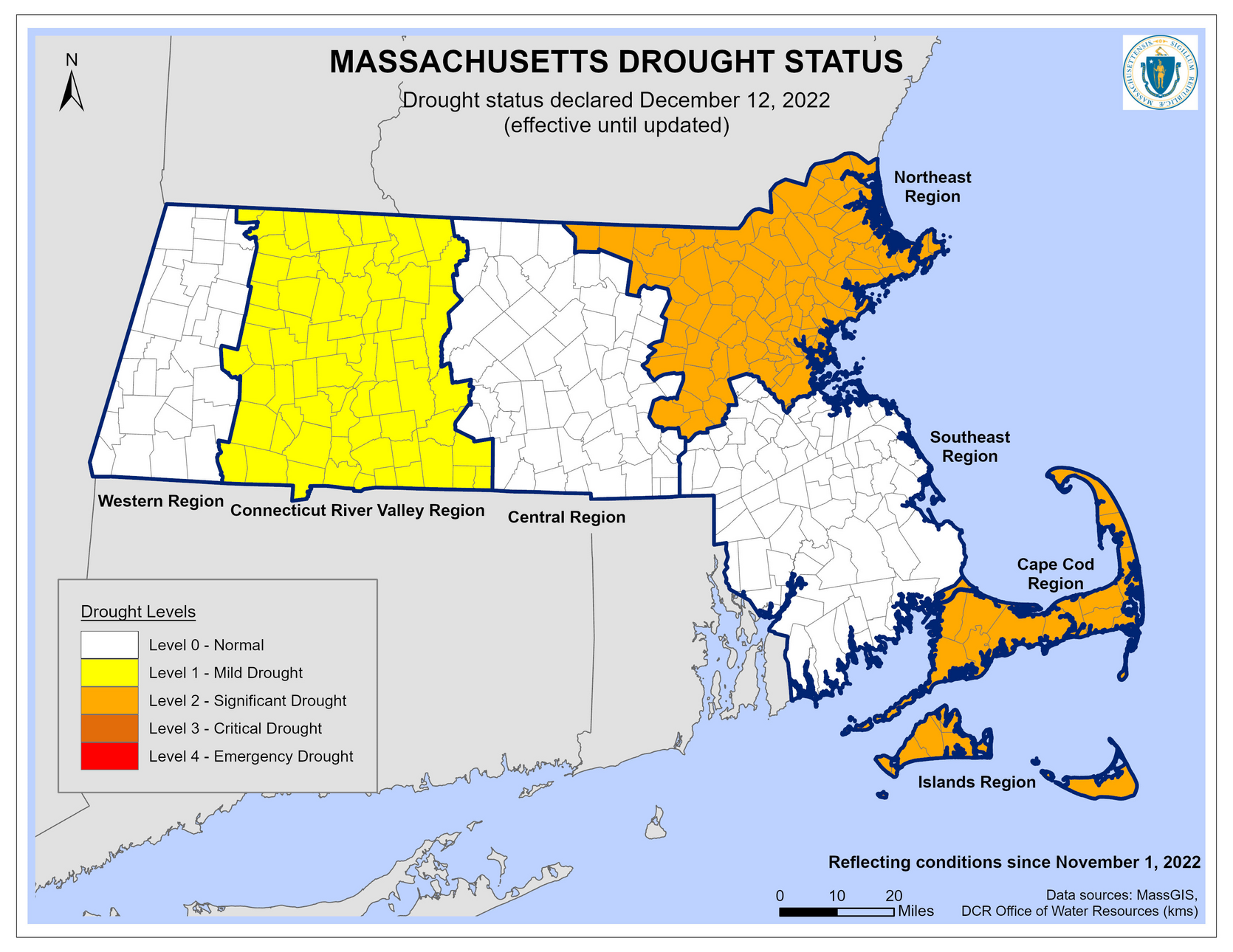- Drought Management Task Force
- Executive Office of Energy and Environmental Affairs
Media Contact
Troy Wall, Communications Director

BOSTON — While some parts of Massachusetts experienced minor improvements through the month of November, several regions within the state continue to be impacted by long-term drought conditions, and today Energy and Environmental Affairs (EEA) Secretary Beth Card announced the following drought declarations: the Northeast and Cape Cod Regions have been downgraded and will join the Islands Region at Level 2-Signficant Drought, the Connecticut River Valley Region will remain at Level 1-Mild Drought, and the Western, Central, and Southeast Regions will remain at Level 0-Normal Conditions. Recent rain and snow events in the past few days offer potential improvements, particularly in the Northeast Region of the state; however, precipitation will need to continue in order to make a difference.
As outlined in the Massachusetts Drought Management Plan, a Level 1-Mild Drought warrants detailed monitoring of drought conditions, close coordination among state and federal agencies, and technical outreach and assistance to the affected municipalities. Additionally, a Level 2-Significant Drought calls for the convening of an interagency mission group, which is already meeting, to more closely coordinate on drought assessments, impacts, and responses within state government.
“Even though the weather is getting colder and wetter, we can’t lose sight of the fact that several regions within Massachusetts continue to be impacted by drought conditions,” said Energy and Environmental Affairs Secretary Beth Card. “It is important that everyone, especially those living and working in the Northeast, Cape Cod, and Islands Regions, continue to practice water conservation in order to ensure that our water resources fully rebound.”
Today’s declarations are the result of recommendations made by the state’s Drought Management Task Force, which is composed of state and federal officials, and other entities. The taskforce will continue to meet until water levels return to normal in all affected regions of the state. The task force noted that the Commonwealth experienced below-normal precipitation during the month of November, with departures ranging from 0 to 3 inches below normal, with the northeastern area ranging 2 to 3 inches below normal. Additionally, normal conditions in several regions of the state for this time of year have historically been even colder and wetter than what is currently being experienced.
Below are recommendations for communities and individuals living and working within a Level 2 – Significant Drought region and a Level 1 – Mild Drought region, including those utilizing a private well. Residents and businesses are also asked to check with their local water system in case more stringent watering restrictions are in place.
For Regions in Level 2 – Significant Drought
Residents and Businesses:
- Minimize overall water use; and,
- Follow local water use restrictions.
Immediate Steps for Communities:
- Limit washing of hard surfaces (sidewalks, patios, driveways, siding); personal vehicle or boat washing; and,
- Establish water-use reduction targets for all water users and identify top water users and conduct targeted outreach to help curb their use.
Short- and Medium-Term Steps for Communities:
- Establish a year-round water conservation program that includes public education and communication;
- Provide timely information to local residents and businesses;
- Implement or establish drought surcharge or seasonal water rates;
- Check emergency inter-connections for water supply; and,
- Develop or refine your local drought management plan using guidance outlined in the state Drought Management Plan.
For Region in Level 1 - Mild Drought
Residents and Businesses:
- Toilets, faucets, and showers are more than 60% of indoor use. Make sure yours are WaterSense efficient;
Short- and Medium-Term Steps for Communities:
- Establish a year-round water conservation program that includes public education and communication;
- Provide timely information to local residents and businesses;
- Check emergency inter-connections for water supply; and,
- Develop a local drought management plan.
Furthermore, the Massachusetts Department of Environmental Protection (MassDEP) will continue to provide technical assistance to communities on managing systems, including assistance on use of emergency connections and water supplies.
“Despite the fact that significant rain has fallen so far in December, droughts reflect deficits that build up over time and it will take time for water levels in some parts of the Commonwealth to return to normal,” said MassDEP Commissioner Martin Suuberg. “We continue to urge residents to follow the water-use recommendations of their local water supplier to help protect their water resources for the future.”
It is important to note that the Massachusetts Water Resources Authority (MWRA) water supply system is not experiencing drought conditions, as defined within its individual plan. Private wells, local streams, wetlands, vernal pools, and other water-dependent habitats located within MWRA-serviced areas are being impacted by drought conditions, while water quality in ponds can deteriorate due to lowering of levels and stagnation.
The Drought Management Task Force will meet again on Monday, January 9, 2023, at 12:30PM. For further information on water conservation and what residents can do, please visit EEA’s Drought page and water conservation page. To get the most up-to-date information on the drought indices, go to the state’s drought dashboard webpage. Additionally, the Commonwealth is surveying the public for any drought impacts that are currently being experienced. To participate, please visit the Massachusetts Water Impact Reporter webpage.
###